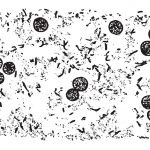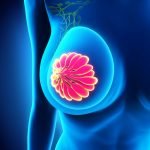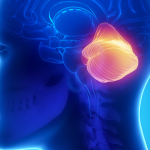As NDs, we are acutely aware of the delicate balance within the endocrine system and how that balance affects one’s health. Understanding the connection between the hypothalamus, pituitary and adrenal glands is crucial when treating a patient with symptoms that point to an endocrine imbalance.
Adrenal Glands
Typically, whenever thyroid dysfunction exists (i.e., hypo- or hyperthyroidism), so do adrenal gland weaknesses. Because the thyroid and adrenal glands work in tandem, it is vital that they be treated simultaneously.
The adrenal glands produce a large number of hormones. The adrenal cortex produces corticosteroids that include the mineralocorticoids, glucocorticoids and gonadocorticoids (androgens). Under prolonged stress, levels of the primary glucocorticoid, cortisol, are elevated; this elevation increases blood pressure and blood sugar levels and suppresses the inflammatory response of the immune system. The androgen DHEA is thought to counteract the negative effects of prolonged elevated cortisol levels, such as immune suppression and impaired cognitive function. However, data is scarce on long-term use. The adrenal medulla is the principle site of the synthesis and release of the catecholamines adrenaline, noradrenaline and dopamine.
Low adrenal function may be caused by deficient corticotrophin-releasing hormone (CRH), or by adrenal fatigue. When humans were hunter-gatherers there were long periods of time between exposures to stress, where the body could recover. Today, the fight-or-flight response is activated so frequently throughout each day that for most people, the body never gets a chance to recover and levels of stress hormones become chronically elevated. This situation has a negative impact on thyroid function, since elevated cortisol can inhibit conversion of T4 to T3 and can decrease TSH output. This may be the body’s way of conserving energy and slowing down metabolism (Teitelbaum, 2001).
Under chronic stress, the adrenal glands cannot keep up with the demand for hormone production due to exhaustion of nutritional reserves or damage to the glands themselves, resulting in low production of adrenal hormones and resulting symptoms such as fatigue and hormone imbalances.
Uterine Leiomyomas
A uterine leiomyoma (fibroid) can form on the interior muscular wall, as well as on the exterior of the uterus. Symptoms can include: menorrhagia, with the likelihood of anemia; shortened menstrual cycles; metrorrhagia; fatigue; increased vaginal discharge; painful sexual intercourse; and pain or pressure in the bowel or bladder.
Since fibroids tend to increase during pregnancy and decrease during menopause, presumably due to fluctuating levels of estrogen, uterine fibroids are considered to be estrogen-dependent (Pollow et al. 1978). Alterations in estrogen metabolism within the fibroid itself may play a role in fibroid growth. Concentrations of estrogen receptors in fibroid tissue are higher than in surrounding myometrium, but lower than in the endometrium (Wilson, 1980).
In hypothyroidism, there is increased activity of the pituitary gland aimed at trying to stimulate the thyroid to produce more hormone secretions, and the increased pituitary activity may affect the ovaries and increase their estrogen output.
What qualifies as excessive menstrual blood loss? The definition depends more on an increase from baseline. Return of menses after a four-year hiatus for the patient described in the accompanying case study has come with heavier bleeding (25 days of heavy bleeding vs. 7-10) and an increase in uterine fibroid size.
Although there are many cofactors, the trigger for fibroids is primarily hormonal. Astringent, hormone-balancing herbs can shrink fibroid growth, lessen estrogen and reduce heavy blood loss (Mills, 1992).
Hormone-Balancing Botanicals
- Alchemilla vulgaris is an astringent herb historically used for heavy bleeding and other menstrual irregularities (Petcu, 1979). The saponins in Alchemilla support the body in adapting to changing hormone levels by reducing the effect of estrogen withdrawal (Mills and Bone, 2000).
- Glycyrrhiza glabra has an indirect effect on the adrenal glands via the liver. It inhibits 5-beta-reductase, an enzyme in the liver that inactivates cortisol by converting it to cortisone. The effect of the glycoside glycyrrhizin is to block the action of 11-beta-hydroxysteroid hydrogenase, a renal enzyme that also catabolizes cortisol (Tamura et al., 1979; Armanini et al., 1996).
- Curcuma longa works well with Glycyrrhiza to reduce stress-induced inflammation (Mitchell, 1999). It may also work to increase plasma cortisol levels over time (Srivastava, 1985).
- Panax ginseng acts to increase ACTH and cortisol secretion via ginsenoside activity, and likely exerts its adaptogenic effects indirectly via the entire hypothalamic-pituitary-adrenal axis (Haia et al. 1983). Panax is also used to improve memory (Mills and Bone, 2000). Vitex agnus castus acts as a dopaminergic agonist, and is indirectly progesteronic. It is indicated for progesterone deficiency (Mills, 1991) and menorrhagia (Mills, 1992; Christoffell et al., 1999); it can also prove to be beneficial in menopausal symptoms, withdrawal from hormone replacement therapy, and conditions where unopposed estrogen plays a role (e.g., fibroids) because of its progesterone favoring effect (Cliff and Heymann, 1992). Vitex exerts a progesteronic effect by acting on the pituitary gland to increase luteinizing hormone (LH) and decrease follicle-stimulating hormone (FSH) (DeCapite, 1967; Weiss, 1988).
Precautions: Vitex agnus castus may counteract the effectiveness of BCPs and other hormone therapies (Tilgner, 1999).
- Capsella pastoris-bursa functions as an anti-hemorrhagic. It is indicated for excessive or irregular menstrual bleeding, and tonifies pelvic organs (Tilgner, 1999). The German Commission E supports using Capsella for symptomatic treatment of menorrhagia and metrorrhagia (Blumenthal et al., 1998).
Janice Skelton, ND currently practices at Dynamic Pathways Wellness center in Phoenix. She is a 1999 graduate of NCNM and is passionate about using herbs, homeopathy and pranayam to support individuals living with brain injuries and other neuroendocrine disorders. As a general practitioner, she believes that virtually all dis-ease can be healed with basic naturopathic care and by living an inspired life.
Case Study
A 51-year-old undernourished Caucasian woman presented to my office in October 2007 with complaints of extremely heavy and long periods, fatigue, depression and a desire to stop HRT; her periods consisted of 20-25 days of bleeding, using one super tampon and overnight pad per hour. She was taking self-prescribed calcium-magnesium, B-complex, buffered vitamin C and alpha-lipoic acid, along with physician-prescribed levothyroxine (T4), SC pellets of estrogen, and testosterone (injected quarterly) with oral progesterone, taken the last three days of each month.
Symptoms are described as weight loss and emotional crashes (weepiness) with HRT, lack of motivation, poor memory, mood swings, anxiety, poor sleep and dizziness.
Pertinent PMHX: menopause at age 46; HRT initiated in October 2006; heavy menses with spotting resuming August 2007. Menses have always been heavy and regular, with uterine cramping, clotting and spotting between periods, 30-day cycles with 7-10 days of heavy bleeding; PMS symptoms of ‘crying jags’; Gravida 2 Para 1; 12 years BCP use. Uterine fibroids diagnosed via ultrasound in 1992.
- Pertinent current MHX: BP LAS: 100/58mmHg; Hippus test (pupil contraction): positive bilaterally
- Salivary hormone panel reveals:
-
- DHEAS: 2.2ng/ml (low <2.0ng/ml)
- Morning cortisol: 3.0ng/ml (low <3.7ng/ml)
- Noon cortisol: 3.0ng/ml (low <3.0ng/ml)
- Evening cortisol: 1.3ng/ml(low <2.0 ng/ml)
- Night cortisol: 0.3ng/ml (low <1.5ng/ml)
- Estradiol: 1.1pg/ml (low <1.5pg/ml; optimal range is 1.5-3.5pg/ml)
- Progesterone: 21pg/ml (normal range for progesterone replacement = 30-300pg/ml)
- Testosterone: 19pg/ml (age dependent range = 16-55pg/ml)
- Serum CRP: 1.1mg/L (reference range 0.8-3.1mg/L)
- T4: 7.6ug/dL with T4 supplementation (reference range 4.5-12.5ug/dL)
- Pelvic US shows 2 submucosal, medium-sized fibroids
- Endometrial biopsy: negative
The patient was started on Vitex agnus castus 250mg qAM along with an aqueous/alcohol tonic of 2oz Alchemilla vulgaris, 2oz Glycyrrhiza glabra, 2oz Capsella bursa-pastoris, 1oz Panax ginseng and 1oz Curcuma longa; sig 120gtt TID, increase to 1tsp QH during heaviest bleeding until flooding slows. She was also prescribed an OTC liquid iron formula in a base of herbs and honey. The patient continued on with calcium-magnesium, B-complex, alpha-lipoic acid and levothyroxine. The SC pellets of estrogen, IM testosterone, and oral progesterone were discontinued.
Follow-Up
After three months, the patient reported regular menses with normal flow. Spotting occurs for an additional 7-10 days. The rest of her symptoms have disappeared. My theory is that a combination of adrenal support and adaptogenic and alterative botanicals has resulted in the return of regular cycles, initiated by HRT.
It is likely that preexisting submucosal fibroids increased in size due to exposure to unopposed estrogen replacement and was contributing to heavy menses and continued spotting.
References
Armanini D et al: Further studies on the mechanism of the mineral corticoid action of licorice in humans, J Endocrinol Invest 19:624-9, 1996.
Blumenthal M et al (eds): The Complete German Commission E Monographs Therapeutic Guide to Herbal Medicines. Austin, 1998, American Botanical Council.
Christoffell V et al: In: Loew D et al (eds): Phytopharmaka v, Forschung und Klinische Anwendung Darmstadt. Heidelberg, 1999, Steinkopff.
Cliff M and Heymann H: Descriptive analysis of oral pungency, J Sensory Stud 7(4):279-290, 1992.
DeCapite L: Histology, anatomy and antibiotic properties of Vitex agnus castus, Ann Fac Agr Univ Studi Perugi 22:109-126, 1967.
Haia S et al: Evaluation of corticosterone secretion-inducing effects of ginsenosides and their pro-sapogenins and sapogenins, Chem Pharm Bull 31:168-74, 1983.
Mills SY: Out of the Earth: The Essential Book of Herbal Medicine. London, 1991, Viking Arkana (Penguin).
Mills SY: Women’s Medicine: Vitex agnus castus, The herb. Christchurch, 1992, Amberwood.
Mills SY and Bone K: Principles and Practices of Phytotherapy: Modern Herbal Medicine. Edinburgh, 2000 Churchill Livingstone.
Mitchell W: Plant Medicine: The Plant Years, Seattle, 1999, Self-published.
Petcu P et al: Treatment of juvenile meno-metrorrhagia with Alchemilla vulgaris fluid extract, Clujul Med 52(3);266-70, 1979.
Pollow K et al: Estrogen and progesterone binding proteins in normal human myometrium and leiomyoma tissue, J Clin Chem Clin Biochem 16:503, 1978.
Srivastava R and Srimal RC: Modification of certain inflammation-induced biochemical changes by curcumin, Indian J Med Res 81:215-223, 1985.
Tamura Y et al: Effects of glycyrrhetinic acid and its derivatives on delta-4, 5-alpha- and 5-beta reductase in rat liver, Arzneim Forsch 29:647-9, 1979.
Teitelbaum J: From Fatigued to Fantastic, New York, 2001, Avery Publishing.
Tilgner, S: Herbal Medicine from the Heart of the Earth. Creswell, 1999, Wise Acre Publishing, pp. 51-52, 79-107.
Weiss RF: Herbal Medications (1st English ed). Beaconsfield, 1988, Beaconsfield Pub, pp.317.
Wilson E et al: Estradiol and progesterone binding in uterine leiomyomata and in normal uterine tissues, Obstet Gynecol 5:20, 1980.




